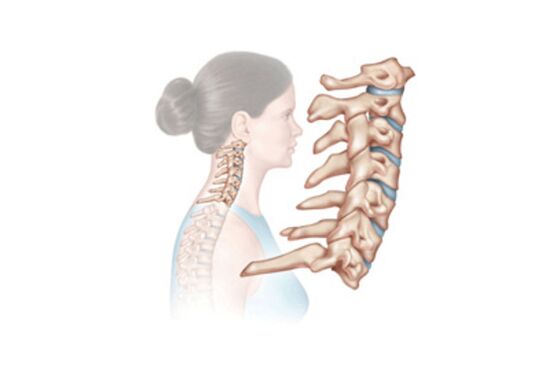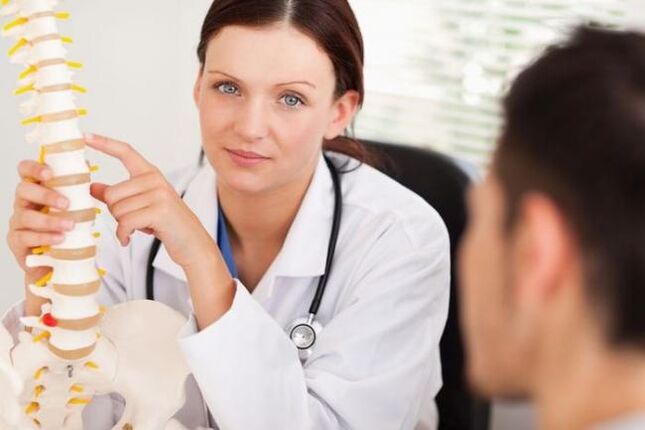
Cervical osteochondrosis or osteochondrosis of the cervical spine is a common disease of knowledge workers. Rapidly advancing disease. Increased frequency of early strokes is associated with cervical osteochondrosis, which is complicated by the development of disc herniations. An MRI scan is required for diagnosis.
What is cervical osteochondrosis?
Cervical osteochondrosis is a common cause of neck pain, headache, increased pressure, shoulder pain, numbness in the fingers, pain under the scapula. Currently, the incidence of cervical osteochondrosis has increased significantly as the role of the computer in our lives has increased.
However, a fall or injury can stimulate the onset of osteochondrosis, and over time, degeneration (wear) of the intervertebral discs can cause symptoms.
Symptoms
In addition to moderate or mild pain, stiffness in the neck, and in some cases impaired mobility, many patients with cervical osteochondrosis experience numbness, tingling, and even weakness in the neck, arm, or shoulder as a result of the chemical exposure. irritation and constricted nerves in the cervical spine.
For example, compression of a nerve root in segment C6-C7 can lead to weakness in the triceps, shoulder, or forearm muscles, weakness in the wrist muscles, "hanging" of the hand, and changes in sensitivity in the middle finger.
Cervical osteochondrosis also often leads to the development of stenosis (narrowing) of the spinal canal and other progressive conditions, such as intervertebral hernia. How does this happen?
Osteochondrosis is, as a rule, nothing more than degeneration of vertebral structures caused by the natural aging of the body. With age, the ligaments thicken, bone protrusions form in the vertebrae, and other changes occur. When the ligaments of the spine thicken or bone protrusions appear, as well as for a number of other reasons, there is less room for bone growth. nerves inside the spinal cord and spinal canal. This condition is called stenosis, ie. narrowing of the spinal canal. Severe narrowing of the spinal canal can cause the nerve roots or even the spinal cord itself to constrict.
Intervertebral hernia is also often the result of degeneration. Intervertebral discs serve as a shock absorber between the vertebrae, thus preventing their destruction. Over time, the disc loses moisture and nutrients, becomes flattened, becomes more brittle and less elastic. As a result, a crack may form in the annulus, through which part of the nuclear pulp is compressed into the spinal canal. This condition is called an intervertebral hernia. If the intervertebral hernia compresses a nearby nerve root, pain syndrome and / or related neurological symptoms occur.
Diagnostics
Successful diagnosis of cervical osteochondrosis begins with a doctor's consultation. The doctor compiles the patient's medical history and conducts a physical examination to check the mobility and sensitivity of the neck. During the examination, the patient may be required to perform certain actions and report how the pain symptoms have changed (increased or decreased).
If the test shows that additional tests are needed, your doctor may recommend x-rays, such as X-rays, magnetic resonance imaging (MRI), or computed tomography (CT) scans. These diagnostic tests, with varying degrees of reliability, can confirm the presence and localization of osteochondrosis, as well as identify other conditions (such as calcification or arthritis) that may be the cause of the patient's symptoms.
Currently, the best option for X-ray examination is MRI, because with the help of magnetic resonance imaging to obtain high-quality detailed images of not only bone tissue, but also soft tissues of the spine, including muscles, ligaments, vessels, nerves and intervertebral discs. it is possible to do. CT is usually prescribed when there are any contraindications to MRI, the main of which is the presence of metal structures or devices in the body (artificial joints, pacemakers, etc. ). The quality of CT is lower than the quality of MRI, but it can also show the condition of the soft tissues of the spine.
Treatment of cervical osteochondrosis
Conservative (non-surgical) treatment of osteochondrosis is always recommended as the main strategy, and surgical intervention is considered if complex conservative treatment does not work for at least six months or if pain and other symptoms significantly interfere with the patient's daily activities. .
Methods used in the conservative treatment of cervical osteochondrosis may include:
- spinal traction (traction). Recently used weightless spinal traction methods allow to completely eliminate the complications of this method of treatment, without which you can not do traction with the load. With increasing intervertebral distance, nutrition of all intervertebral discs improves, pain syndrome disappears.
- Therapeutic gymnastics. . Therapeutic gymnastics can improve the mobility of the spinal segment. Because the intervertebral discs perform their functions, hernias and protrusions do not grow or form in the mobile vertebral segment.
- mass therapy.
- drug treatment. Includes NSAIDs (non-steroidal anti-inflammatory drugs) and painkillers. In most cases, the temporary effect of drug treatment is small or non-existent.
- neck corsets, orthopedic pillows. They can be recommended to stabilize the cervical spine and reduce pressure on the nerve root after trauma and spinal fractures.
Surgical treatment of cervical osteochondrosis
If there is no significant relief after six months of conservative treatment and the daily regimen becomes difficult for the patient, surgery may be considered. Typically, for cervical osteochondrosis, a procedure called spinal fusion is performed to immobilize the affected vertebral segment. This operation involves the removal of the intervertebral disc, the decompression of the nerve root, and the placement of a bone or metal implant to maintain or create normal disc space and stabilize the spinal segment.
As a rule, the vertebral joint is performed in one vertebral segment, and in rare cases, surgery on two spinal segments may be considered. However, the patient should be aware that surgery to relieve neck pain symptoms results in less positive outcomes than similar surgery to relieve pain in the arm with cervical osteochondrosis. Therefore, if neck pain is the main or only symptom, spinal fusion should only be recommended as a last resort, or if all conservative treatments have been tried and failed. If the disc cavity cannot be identified as the most likely source of neck pain, it is better to avoid surgery, even if conservative treatment does not provide significant relief from the pain. In addition, keep in mind that spinal surgery is performed both in the operated area (local infection, implant rejection, etc. ) and for the whole body (blood clots, allergic reactions to drugs, etc. ). Therefore, before deciding on surgical treatment, it is necessary to discuss all the details of the operation with the surgeon who will perform it directly. It should be noted that surgery on the cervical spine leads to spinal disability in most patients.
What is cervical osteochondrosis?

Formal medicine interprets osteochondrosis as a degenerative-dystrophic damage to the intervertebral discs.
The definition of the disease is also given from which part of the spine these discs are located.
Let's take a special look at the symptoms of cervical osteochondrosis, which accounts for almost 80% of all diseases of the spine.
The sad fact is that the disease reaches the highest level of working capacity in the category of patients aged 30 to 50 years.
In young people, the disease acts as an independent disease, a pathology that has developed against the background of other diseases of the joints at an older age.
How does the disease develop?
The gradual development of the disease is characteristic of any part of the spine. Cervical osteochondrosis does not go beyond this framework, so it is worth going into detail at each stage.
- In the initial stage, the intervertebral discs are gradually destroyed. Between them is an annulus fibrosus, where cracks are visible, which leads to a decrease in the elasticity and strength of the discs. They narrow and squeeze the nerve roots.
- The second stage is the result of the first stage untreated. The initial destruction of the discs becomes chronic, tissue compression occurs, dislocation of the cervical vertebrae is observed. Dizziness syndrome often develops at this stage.
- In the third stage, the pain intensifies, constant headaches appear, the sensitivity of the upper extremities is lost, the cervical "lumbago" suffers. This is due to the fact that at this stage the fibrous ring is almost completely destroyed.
Often, third-degree cervical osteochondrosis has a decrease in pain sensations. This happens when the cartilage tissue is gone and there is nothing to damage.

Reasons
In general, given the prevalence of osteochondrosis, doctors began to study its causes more closely. Most of the negative factors have been identified, but there is no exact list. What has been revealed so far is:
- sedentary lifestyle;
- any intoxication and infection;
- great physical activity;
- to smoke;
- constant weight lifting;
- stress and nervous tension;
- uncomfortable shoes or an irregular foot that creates unnecessary pressure on the spine;
- malnutrition;
- frequent hypothermia and exposure to bad weather;
- age-related changes;
- spinal cord injury;
- weak heredity;
- abrupt refusal to train, if they have been engaged for a long time before.
After getting acquainted with the causes, it becomes clear that cervical osteochondrosis can occur at any age. If the symptoms of osteochondrosis are initially insignificant and are marked by rare pain attacks, it is also impossible to turn the neck over time and it is difficult to bend the head. And this is not the only danger of the disease.
What is the danger of the disease
Our neck is a great worker. He works all day and his little vertebrae can withstand all our turns and bending of our heads. When the bones move, the nerves constrict and the blood vessels constrict, and the vertebral artery, which is responsible for nourishing the brain, also passes through the cervical spine. The artery constricts, the nerve root constricts, and the inflammatory process begins.

What does this lead to? Spinal cord injury, ischemia, intervertebral hernia - these are serious consequences of cervical osteochondrosis. Here we add a general decrease in mobility and the formation of osteophytes. As a result, we have a disability that threatens complete immobility. With such a disappointing prognosis, it is important to quickly recognize the symptoms of cervical osteochondrosis.
Symptoms

The shortest way to diagnose osteochondrosis is the patient's complaints. So, how does a person feel when the cervical vertebrae are destroyed? The picture of the disease looks like this:
- dizziness;
- Severe headache;
- "Flies" and colored spots in the eyes against the background of headache;
- pain when turning, lifting weights;
- pain that spreads to other organs (heart area, other organs).
Sometimes the symptoms of osteochondrosis can be listed among other diseases, but even if they are temporary, they can not be ignored.
Diagnosis and treatment
Continuing the feelings expressed by the patient, the neurologist continues to make a more accurate diagnosis of the disease. A few years ago, only X-rays were in the arsenal of doctors to diagnose osteochondrosis. Today, computed tomography and magnetic resonance imaging are actively used. They allow you to accurately determine the stage of the disease.
After assessing the situation, a specialist vertebroneurologist prescribes the necessary treatment. The first thing the doctor takes is to relieve the pain, then the swelling and inflammation. Such anti-inflammatory drugs are used to relieve pain. As we recall, the constriction of the vertebral artery disrupts the supply to the brain, which needs to be improved. This is done with the help of muscle relaxants.

Knowing that the symptoms and treatment of cervical osteochondrosis are related to the spine, massage and physiotherapy exercises are definitely included in the set of health measures. Massage is performed by a specialist and the patient himself. There are also special exercises aimed at developing the cervical vertebrae and restoring their mobility.



















